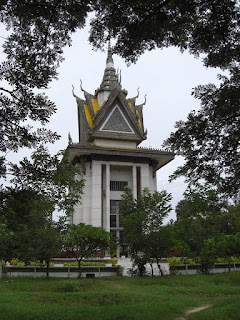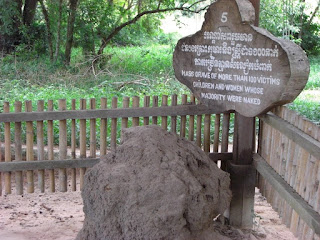N 11 deg 29.070
E 104 deg 54.085
Today was somber. It was overcast with scattered showers. But also, genocide with scattered victims.
We woke early to board a flight to Cambodia and bid Thailand farewell. We arrived in Cambodia’s capital, Phnom Penh. The cloudy sky and prevailing wind let the air feel surprisingly cool. In order to work around the local siesta time, we headed straight to the first stop on our tour, the Killing Fields.
I studied briefly about the Pol Pot rebellion and the Khmer Rouge killings. But it wasn’t until this stop that I really gained an understanding of what it all meant. As we walked up to the entrance, we were greeted with a tall tower. It had about 8 layers, each stacked with skulls pulled out of the mass graves in these killing fields.


We walked around the gruesome grounds. We came to many dug-up holes in the ground, now grown over with weeds. Each was a mass grave. It looked like there must have been 4 dozen in this small area no greater than a quarter acre. Some had fences around them with signs explaining what made them different than the others.

“Mass grave of more than 100 victims children and women whose majority were naked”
One tree is famous. The guards would take small children by the feet and swing them like baseball bats into the trees until they died.

“Killing tree against which executioners beat children”
At this point I noticed I saw lots of clothes along the ground. The guide casually told me that was the clothes of the people who were buried. I was shocked. There were parts where piles of clothes were right on the top of the ground. At first I was skeptical. As I continued walking I saw more and more, all of which looked as if it was half buried and weathered. It was sobering to know that this massacre was recent enough that the cloth was in good enough condition I could see the striped patterns on a man’s shirt.

Clothes that comes up from the graves when they flood with rain water
N 11 deg 32.975
E 104 deg 55.064
Following that, we silently sat in the van as we were taken to Security 21 (S-21). That is the most famous torture prison the Khmer Rouge used. S-21 was a high school that was converted to a veritable Auschwitz. In some places, the bullet holes looked fresh and the blood still had not been completely removed.

Typical Cell
There were also pictures of the people involved. The majority of the killing was done not by men, but rather children. Boys as young as 13 and often not older than 18 would be given guns, but were instructed to use sticks and cheaper, more painful methods of killing. They did so gladly.

The killers
And the victims ranged from newborns, as you saw above with the tree, to the elderly. Although the educated and skilled were the most targeted, no one was safe from this tyranny.
Our tour guide survived this mess. His dad was in support of the Khmer Rouge when great promises were offered. When the Khmer Rouge came to power there were parties in the streets. Suddenly, the soldiers started firing on the crowd and evacuated the entire capital city. Our guide’s father told the family not to worry, that this was his party and there was a misunderstanding. He went out to greet the soldiers. They turned and nearly shot him. The father tried to speak to the children with guns, but it was clear he was going to get nowhere except a grave if he persisted. He came back inside, looked as his family and told them to grab as much rice as they could. “Something is wrong. Everything has changed. We must leave.”
They left to a remote village and although they were successful and educated people, masqueraded as peasants. That saved their lives. They worked as many as 12 hours a day as slaves but kept their heads down and survived. Our guide was not emotional about the experience, but you could tell it forever changed him.
I have been to not one, but two of the World War II Nazi prison camps. Both were also sad and loathsome places. But the freshness and reality of this was more than I could have expected.
While I could never defend the actions of Hitler, I can somewhat understand him. He had goals. He wanted to perfect his master race of fellow Germans. He felt Jews (and others) who were threats were to be killed, or even used as slave labor or experimental fodder. While vile none the less, one could make sense of his evil plotting. But this was beyond reason. This was Cambodians killing Cambodians. There was no plan here. There was no goal. To this day no one knows what, if anything, Pol Pot and his lot were ultimately hoping to accomplish. 1.7 million people died directly from this regime, and incidental deaths total 3.5 million. Nearly half of the entire country was wiped out as a result and we are only left to scratch our heads and wonder, “Why?”
I think the part that affected me the most were the portraits. Many records were taken of both the victims and the assailants. I looked into the eyes of the unfortunate captives. I found myself lost in a sea of faces; peering into my soul through the photographs and, indeed, from beyond the grave. Faces that I will never forget.


No comments:
Post a Comment